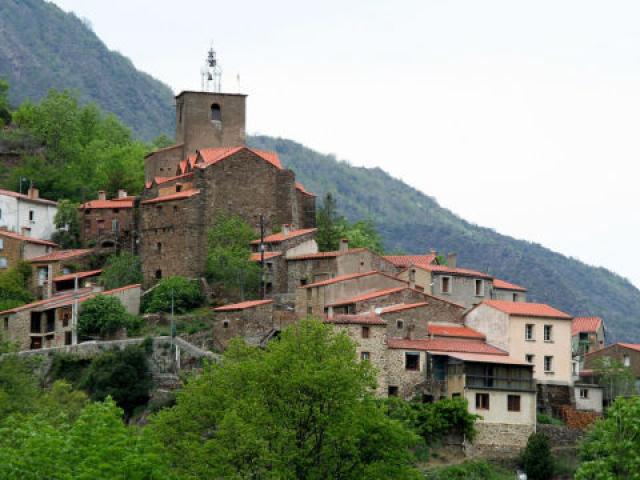Baillestavy

General information:
Where silence rhymes with memory
In the hollow of the Lentillà Valley, at an altitude of nearly 600 meters, Baillestavy emerges—humble and peaceful—like a haven far from the hustle and bustle of modern life. Perched between two banks, the village embraces the panoramic views of the Canigó Massif, a Catalan landmark preserved by a Grand Site de France designation.
A village with two faces
Formed from two complementary hamlets—La Torre, perched on a peak and home to the church, and La Farga, nestled on the banks of the river—Baillestavy weaves its dwellings like a stone history booklet. An elegant, arched medieval footbridge connects these two peaceful worlds, witnesses to a recent and more distant past.
The memory of iron and faith
The Church of Saint-André, whose bell tower was once a castle tower, embodies the fusion of the sacred and the military. It dates from the 17th century, but rests on older foundations and features a statue of the Virgin Mary, a relic from the 13th century.
A few steps away, the carefully restored Saint Andrew Chapel stands in a meadow by the water. It sits on an ancient iron mining site, exploited since the 1st century BC.
These buildings are complemented by a permanent exhibition, housed in the church, describing the long-standing metallurgical use of the Lentillà and Canigó massifs.
Vestiges of this industrial era: ore roasting furnaces, old mines, and coal pits, dot the surrounding wild forest.
An inspiring natural environment
Framed by ridges culminating at 1,700 m, Baillestavy is nestled in dense vegetation—oaks, beeches, birches, firs, poplars, and chestnut trees—where forests and summer meadows extend along the ridge paths between 1,100 and 1,800 m.
The presence of Natura 2000 areas, as well as environments of rich ecological interest, gives the area a green, fragile, and precious setting.
A discreet and solidary village life
A small rural commune, Baillestavy currently has between 110 and 120 inhabitants, including permanent residents and second-home owners. The village seems frozen in an almost immutable calm, but it breathes a simple community life, fueled by a bar-restaurant, one or two gîtes, artisans, livestock farmers, a small amount of local agriculture, and a discreet presence of teleworkers.
Local associations, a library, weekly yoga, and Iron Day... despite its size, Baillestavy strives to maintain friendly connections and rituals.
A drive toward the future, rooted in the past
The old furnaces, the hydraulic forge ("La Farga") whose name still exists, the mines, and the religious heritage bear witness to an identity forged between nature and ancient industry. These historical layers, set in an environment as vibrant as it is tranquil, make Baillestavy a place of remembrance, gentle adventure, and contemplation.
How to get there?:
Conflent
Practical information:
What can't you miss?:
Where silence rhymes with memory
In the hollow of the Lentillà Valley, at an altitude of nearly 600 meters, Baillestavy emerges—humble and peaceful—like a haven far from the hustle and bustle of modern life. Perched between two banks, the village embraces the panoramic views of the Canigó Massif, a Catalan landmark preserved by a Grand Site de France designation.
A village with two faces
Formed from two complementary hamlets—La Torre, perched on a peak and home to the church, and La Farga, nestled on the banks of the river—Baillestavy weaves its dwellings like a stone history booklet. An elegant, arched medieval footbridge connects these two peaceful worlds, witnesses to a recent and more distant past.
The memory of iron and faith
The Church of Saint-André, whose bell tower was once a castle tower, embodies the fusion of the sacred and the military. It dates from the 17th century, but rests on older foundations and features a statue of the Virgin Mary, a relic from the 13th century.
A few steps away, the carefully restored Saint Andrew Chapel stands in a meadow by the water. It sits on an ancient iron mining site, exploited since the 1st century BC.
These buildings are complemented by a permanent exhibition, housed in the church, describing the long-standing metallurgical use of the Lentillà and Canigó massifs.
Vestiges of this industrial era: ore roasting furnaces, old mines, and coal pits, dot the surrounding wild forest.
An inspiring natural environment
Framed by ridges culminating at 1,700 m, Baillestavy is nestled in dense vegetation—oaks, beeches, birches, firs, poplars, and chestnut trees—where forests and summer meadows extend along the ridge paths between 1,100 and 1,800 m.
The presence of Natura 2000 areas, as well as environments of rich ecological interest, gives the area a green, fragile, and precious setting.
A discreet and solidary village life
A small rural commune, Baillestavy currently has between 110 and 120 inhabitants, including permanent residents and second-home owners. The village seems frozen in an almost immutable calm, but it breathes a simple community life, fueled by a bar-restaurant, one or two gîtes, artisans, livestock farmers, a small amount of local agriculture, and a discreet presence of teleworkers.
Local associations, a library, weekly yoga, and Iron Day... despite its size, Baillestavy strives to maintain friendly connections and rituals.
A drive toward the future, rooted in the past
The old furnaces, the hydraulic forge ("La Farga") whose name still exists, the mines, and the religious heritage bear witness to an identity forged between nature and ancient industry. These historical layers, set in an environment as vibrant as it is tranquil, make Baillestavy a place of remembrance, gentle adventure, and contemplation.
How to get there?:
Conflent
Practical information:
Saint Andrew's Church (10th-11th centuries) in the cemetery and excavations (site of the first village)
Saint Andrew's Church (17th centuries) in La Torre (upper village)
Iron ore roasting kilns (Vallmanya road, km 3)
Rabolledes lime kiln
Ancient farmhouses
Drilled rocks
Medieval humpback bridge
What can't you miss?:
